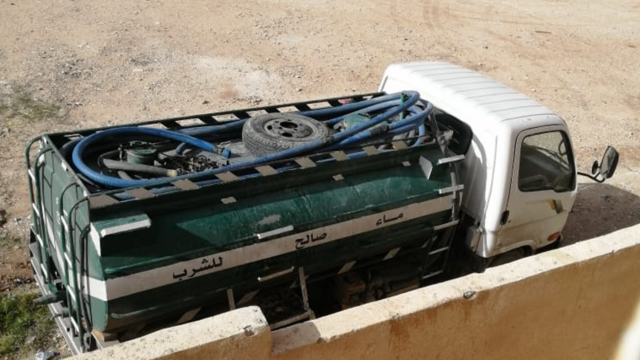Water access in the drylands – what’s not working?
Despite major investments in water infrastructure in dryland areas in recent years, the functionality and sustainability of these investments remains a major challenge. Guest blogger Claire Bedelian discusses some of the issues based on findings from a recent study in Kenya.

Residents access water in Wajir county, Kenya (Photo: copyright Adaptation Consortium)
Secure and reliable access to water is critical to the livelihoods of dryland communities. In Kenya’s drylands, county governments are investing in new water points to support livelihoods and adapt to climate change.
Yet reports show some water points are not functioning only two years after installation. And further data show 25% of water points after four years are not working.
When water points break down, communities are forced to use alternative water sources that may be unsafe, they may suffer long waiting times or need to migrate long distances in search of water.
Given government efforts to enhance water availability, why is sustainable water provision failing in the drylands?
Focusing on water infrastructure at the expense of good water governance is one major reason. Good governance includes considering who decides where new water points are put and the needs of the water point’s multiple users.
It also includes planning for who will carry out regular maintenance and from where spare parts will be sourced when water points break down.
Rainfall in the drylands is variable and patchy so it is critical to place new water points in light of livestock wet and dry season grazing areas and livestock mobility patterns. Failing to consider these patterns can cause pasture degradation, poor livestock productivity, and increased conflict between herders.
Achieving sustainable access to water does not only depend on physical infrastructure and technical issues, but on the management and governance systems in place to deliver water.

Goats drinking water from a trough at Yamicha borehole in Isiolo county (Photo: copyright Adaptation Consortium)
Study roots out reasons for poor functionality
To understand the reasons behind poor water functionality in Kenya’s drylands, the Adaptation Consortium, IIED, and partners ADLEF, WOKIKE, MIDP and ADSE, in collaboration with the BRECcIA project, co-developed a functionality study in five dryland counties.
The study assessed the functionality of water investments implemented through the County Change Climate Fund (CCCF) – a mechanism to enable communities to decide how climate adaptation funds are spent so they can build their resilience to climate change.
Communities at village level decide how money from the CCCF is invested. Almost all investments in the five counties focus on improving availability and access to water, reflecting the critical role of water in strengthening resilience.
Water investments are managed by community water management committees, and include motorised boreholes, water pans, sand and earth dams, shallow wells, and rock catchments.
The study found that 63% of investments were functioning and operating well. Another 23% were partially functioning with water still accessible but limited. The remaining 14% were not functioning, with the community unable to access any water.
The study revealed a combination of technical and management factors that are causing the investments to work only partially, or to fail completely. This included problems with design and workmanship, the siting of investments, damage from floods, vandalisation and a lack of repairs and maintenance.
The reasons behind failure are complex and multi-layered
Further investigation into the underlying causes of poor functionality showed that technical and management problems can be explained by a mix of governance, institutional capacity, technology and financial deficiencies. These occurred throughout the project cycle, from design to implementation and management.
The community management model also brought challenges – including technical capacity gaps, unclear roles and responsibilities, lack of a sustainable spare parts chain and problems with revenue collection. There was also limited support for maintenance and repairs from county government and a private sector that failed to support technical services and supply chains.
Drivers of sustainability and inclusion
The CCCF water investments also provide lessons on good practice in planning future sustainable investments in the drylands:
- Most investments are existing facilities that have been repaired or upgraded, minimising expenditure and duplication of investments
- Domestic and livestock water points are separated with livestock troughs, tap stands, and fencing
- This improves access to water for different users, enhances water quality, and reduces conflict
- Water points are prioritised in line with community needs and concerns, and
- Women are at the centre of decision-making across all levels of project development
Early outcomes (PDF) of the CCCF investments find positive benefits for community and household resilience: shorter distances to access water; increased water availability throughout the year; and reduced water contamination.
Greater accessibility benefits women and girls in particular who have more time for education and other household activities. Wider benefits include improved human and livestock health, higher productivity and income, improved livelihoods and ultimately increased food security and wellbeing.
Sustainable water development in the drylands
The study highlights the importance of strong community management and governance systems for functional and reliable water investments. This includes more focus on ‘software’ aspects such as operation and maintenance, good governance practices and an appropriate institutional framework, to accompany the ongoing development of ‘hardware’.
Strong community governance systems are also best placed to manage the sustainable use of variable and dispersed dryland resources. Here, control of access to water is key to ensure water use is carefully matched to the availability of the surrounding pasture.
But communities also need strong support systems from local government and possible outsourcing of the more technical roles to a skilled private sector if they are to sustain functional investments well into the future.
Further integration of climate information services – from seasonal forecasts to long-term projections – into their design and siting, will also ensure investments remain more resilient to climate shocks such as floods.
What is imperative is that the design and siting of water points are done in discussion with all users of the water to ensure that water development is integrated into the sustainable management of dryland areas and the livelihoods of different users. This includes the needs of women and girls, who are responsible for domestic water collection.
As the CCCF is scaled to further counties in Kenya, these findings will help inform the functionality and sustainability of future water investments in the drylands.
- Download the report Improving the functionality of water investments in the drylands




